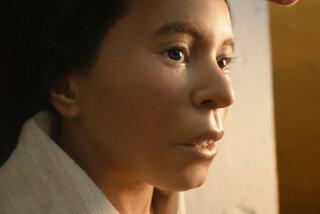They’re Not in O.C. to Unwind
- Share via
Six mummies and other Egyptian artifacts arrived in Santa Ana this week for a two-year exhibit at the Bowers Museum. And they made their debut in the parking lot.
In an effort to publicize the upcoming exhibit, museum officials had the mummies CT-scanned in a truck just outside the building.
On Thursday, museum officials repeated the drill for the news media, pointing out the machine wasn’t actually scanning at that time.
Despite the stunt, the scans were an attempt to learn more about the people mummified and believed to have lived more than 1,800 years ago.
Scientists already knew one mummy was a priest from a wealthy family, while another was a young girl who sang during religious rituals. But by taking thousands of images without unwrapping the mummies, scientists learned about their physical condition in a sort of virtual autopsy.
Although the findings, confined mostly to a better grasp of the mummies’ age, did not mark significant breakthroughs in Egyptology, they made modest advances in the field. Four of the six mummies -- on loan from the British Museum in London -- were X-rayed in the 1960s but had never been CT-scanned.
On Thursday, scientists announced the mummified body of a child thought to be 18 months old was closer to 4 or 5 years of age.
Similarly, the scans allowed scientists to “see” behind the dense death mask of Irthorru, a priest from the city of Akhmin who died about 600 BC.
The CT scans uncovered two large beads on his forehead and an elaborate bead net around the mummy’s case.
“There’s no doubt this individual came from an important family,” said Nigel Strudwick, British Museum curator.
Another man, who lived between 140 and 180, was found with all his organs intact.
“This is rather typical of the Roman period,” he said.
Before the Roman period -- 30 BC to AD 395 -- Egyptians usually removed a person’s organs and replaced them with tightly rolled linen packs.
Many mummification styles have been used throughout history, with the technique becoming refined around 2500 BC.
Generally, the body was packed with salt or resin, then wrapped in linen.
Capable of photographing up to 2,000 images a minute, CT scans are able to “see” countless layers of matter.
Placed on top of one another, the images can be used to make a lifelike three-dimensional picture that can then be manipulated on a computer.
The technology has been used on mummies for at least a decade, including a study of King Tut’s remains that showed the so-called Boy King was probably not murdered as had long been suspected.
Scientists favor CT scans because they leave mummies intact.
“If you unwrap a mummy, you can’t rewrap it,” said Megan Shockro, manager of museum programs at Bowers. “What happens is the bones become displaced once moisture touches them, so you can’t get back to that original place of mummification,” she said.
Norma Kershaw, a museum board member and former professor of ancient art, said the technology went hand in hand with an increased appreciation for mummies and all things Egyptian.
European adventurers, she said, used mummies as firewood when they discovered them in the 18th and 19th centuries.
“There were so many of them, they didn’t care. Then private people bought them and they would have parties and perform dissections in their living rooms.”
On display through 2007, “Mummies: Death and the Afterlife in Ancient Egypt” will also feature jewelry, masks, papyri and sarcophagi.
Funerary boats, which symbolize passage to the afterlife, will also be on exhibit.
The museum will have periodic Saturday lectures.
More to Read
Sign up for Essential California
The most important California stories and recommendations in your inbox every morning.
You may occasionally receive promotional content from the Los Angeles Times.













